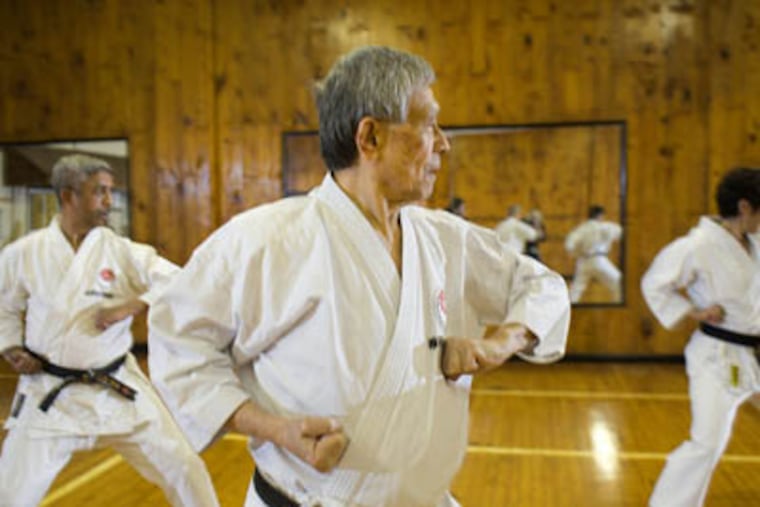Teruyuki Okazaki, 88, was an internationally known karate master
Mr. Okazaki was described as a "living textbook" into the history of shotokan karate.

- Teruyuki Okazaki
- 88 years old
- Lived in Philadelphia
- He mastered karate in Japan and shared his knowledge in Philly
Known throughout the world as the highest-ranked teacher in Shotokan karate, Teruyuki Okazaki once considered quitting the discipline after twice failing his first and second tests to become a black belt.
“He always talked about it,” said nephew Hiroyoshi Okazaki. “He would explain that it doesn’t matter if you pass or fail, so don’t get discouraged. It doesn’t mean failing. It’s just you need more practice. It’s not only techniques but also your attitude.”
Teruyuki Okazaki, 88, who came to Philadelphia from his native Japan in 1961 to teach karate for what was supposed to be only six months but remained for the rest of his life, died Tuesday, April 21, of complications from the coronavirus.
Mr. Okazaki, a 10th-degree black belt, was considered by one writer to be a “living textbook on the history and practice of Shotokan karate,” the characteristics of which were described by his nephew as “very dynamic.”
“When you strike, one blow, one kill,” Hiroyoshi Okazaki said. “Karate is self-defense, and when you face multiple opponents you have to finish your opponent with one strike in order to face the next opponent.”
Mr. Okazaki founded the International Shotokan Karate Federation in 1977. Its headquarters were at his dojo in West Philadelphia, and it has members from more than 60 countries. His nephew, a ninth-degree black belt, is now chairman and chief instructor.
Mr. Okazaki began teaching karate at Temple University in 1970 and continued for many years. He also taught at the University of Pennsylvania and Drexel, West Chester, and Thomas Jefferson Universities.
Born in Fukuoka, Japan, Mr. Okazaki was a somewhat unruly child who was directed into martial arts by his parents. His mother wanted him to learn aikido, but he would practice karate – then a relatively new discipline – on the side.
“My mother knew him when he was younger, and he was really kind of a bad boy,” Hiroyoshi Okazaki said. “He was always getting into fights, just the opposite of what he would become."
He had an intimidating look, but his students soon learned he was very approachable in person.
He joined aikido dojo in practice, but he would train in karate on the side. He later said that Morihei Ueshiba, the master of aikido, saw his action was "not for aikido.”
Mr. Okazaki trained with Masatoshi Nakayama, his mentor, and sometimes with Shotokan founder Gichin Funakoshi. He graduated in 1953 with a political economics degree from Takushoku University and went on to assist Nakayama and Funakoshi with the new Japanese Karate Association.
In 1961, Nakayama sent Mr. Okazaki to the United States to teach the sport. The experience did not start well.
“He couldn’t communicate,” Hiroyoshi Okazaki said. “Of course, that meant difficulty finding food. It took him a long time to kind of settle down. I think many times he wanted to go back to Japan, but Masa Nakayama told him, ‘A little bit longer, a little bit longer.’”
He stayed. He approached officials at Temple to begin a karate class there. While they were receptive, they could only offer 6 a.m. as the starting time.
“So he taught classes early in the morning for a while,” his nephew said. “Little by little, people recognized how great karate is. At that time, back in the ’60s, men and women didn’t practice karate together. It was separate classes. But he told the school that karate is for everyone — men, women, young, old, it doesn’t matter. They practice together. I guess the school liked that idea.”
As he grew more accustomed to U.S. culture, Mr. Okazaki adapted his teaching style, his nephew said.
“When he first came to this country, he was just a traditional karate instructor from Japan,” he said. “The way of teaching was really hard, strict. But gradually he understood the American culture doesn’t work that way, so he developed a special kind of teaching skill.”
Hiroyoshi Okazaki said his uncle was open-minded and a good listener, and never seemed to worry about anything. He had an intimidating look, but his students learned he was “very approachable in person,” his nephew said. And he liked to laugh.
“He joked around a lot,” his nephew said. “He always wanted to hear gossip about students.”
In addition to his nephew, Mr. Okazaki is survived by his wife, Linda; stepson Edward Stuhltrager; a brother; and two step-grandchildren.